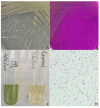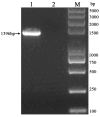Isolation, Identification, and Drug Sensitivity Test of Pseudomonas aeruginosa from Cynomolgus Monkey (Macaca fascicularis)
- PMID: 40711296
- PMCID: PMC12299744
- DOI: 10.3390/vetsci12070636
Isolation, Identification, and Drug Sensitivity Test of Pseudomonas aeruginosa from Cynomolgus Monkey (Macaca fascicularis)
Abstract
In this study, we isolated and identified bacteria from the feces of a diarrheal cynomolgus monkey. The results showed that the isolated strain was P. aeruginosa, named PA/CM-101101. Morphological observations indicated that when cultured on Luria-Bertani (LB) nutrient agar at 37 °C for 24 h, the strain formed smooth, slightly elevated colonies with neat and wavy edges. On acetamide agar at the same temperature and duration, the colonies appeared flat with irregular edges and a faint pink periphery, while the medium changed to rose-red; in LB broth at 37 °C for 24 h, the medium became turbid and yellowish-green. Gram staining revealed that it was negative and rod-shaped, without sporulation characteristics. The 16S rRNA gene sequence analysis showed that the sequence identity of the strain shared more than 98.4% similarity with 11 strains of P. aeruginosa from various sources in GenBank. The animal toxicity test showed that it had a strong pathogenic effect on mice. The results of drug sensitivity tests showed that strain PA/CM-101101 was sensitive to amikacin, azithromycin, cefoperazone, ceftazidime, ceftriaxone, ciprofloxacin, gentamicin, imipenem, levofloxacin, meropenem, norfloxacin, ofloxacin, and polymyxin B; however, it displayed resistance to ampicillin, cefadroxil, cefazolin, erythromycin, and vancomycin. The research findings provide valuable insights for diagnosis and treatment strategies for cynomolgus monkeys. It also provides a reference for molecular epidemiological studies. To our knowledge, this is the first time P. aeruginosa isolated from the diarrhea feces of cynomolgus monkey has been reported.
Keywords: Pseudomonas aeruginosa; cynomolgus monkey; drug sensitivity test; identification.
Conflict of interest statement
The authors declare no conflicts of interest.
Figures




Similar articles
-
Antibiotic strategies for eradicating Pseudomonas aeruginosa in people with cystic fibrosis.Cochrane Database Syst Rev. 2017 Apr 25;4(4):CD004197. doi: 10.1002/14651858.CD004197.pub5. Cochrane Database Syst Rev. 2017. Update in: Cochrane Database Syst Rev. 2023 Jun 2;6:CD004197. doi: 10.1002/14651858.CD004197.pub6. PMID: 28440853 Free PMC article. Updated.
-
Antibiotic strategies for eradicating Pseudomonas aeruginosa in people with cystic fibrosis.Cochrane Database Syst Rev. 2014 Nov 10;(11):CD004197. doi: 10.1002/14651858.CD004197.pub4. Cochrane Database Syst Rev. 2014. Update in: Cochrane Database Syst Rev. 2017 Apr 25;4:CD004197. doi: 10.1002/14651858.CD004197.pub5. PMID: 25383937 Updated.
-
The Black Book of Psychotropic Dosing and Monitoring.Psychopharmacol Bull. 2024 Jul 8;54(3):8-59. Psychopharmacol Bull. 2024. PMID: 38993656 Free PMC article. Review.
-
Systemic pharmacological treatments for chronic plaque psoriasis: a network meta-analysis.Cochrane Database Syst Rev. 2021 Apr 19;4(4):CD011535. doi: 10.1002/14651858.CD011535.pub4. Cochrane Database Syst Rev. 2021. Update in: Cochrane Database Syst Rev. 2022 May 23;5:CD011535. doi: 10.1002/14651858.CD011535.pub5. PMID: 33871055 Free PMC article. Updated.
-
Systemic pharmacological treatments for chronic plaque psoriasis: a network meta-analysis.Cochrane Database Syst Rev. 2020 Jan 9;1(1):CD011535. doi: 10.1002/14651858.CD011535.pub3. Cochrane Database Syst Rev. 2020. Update in: Cochrane Database Syst Rev. 2021 Apr 19;4:CD011535. doi: 10.1002/14651858.CD011535.pub4. PMID: 31917873 Free PMC article. Updated.
References
-
- Maaskant A., Voermans B., Levin E., de Goffau M.C., Plomp N., Schuren F., Remarque E.J., Smits A., Langermans J.A.M., Bakker J., et al. Microbiome signature suggestive of lactose-intolerance in rhesus macaques (Macaca mulatta) with intermittent chronic diarrhea. Anim. Microbiome. 2024;6:53. doi: 10.1186/s42523-024-00338-z. - DOI - PMC - PubMed
-
- Maaskant A., Blees N.R., Smits A., Corbee R.J., Bakker J., Langermans J.A.M., Remarque E.J. Evaluation of commercial diets on fecal consistency and defecation frequency in rhesus macaques (Macaca mulatta) with chronic intermittent idiopathic diarrhea. Lab. Anim. Res. 2025;41:15. doi: 10.1186/s42826-025-00246-6. - DOI - PMC - PubMed
Grants and funding
LinkOut - more resources
Full Text Sources

